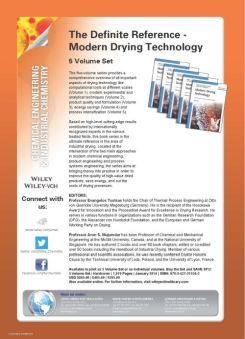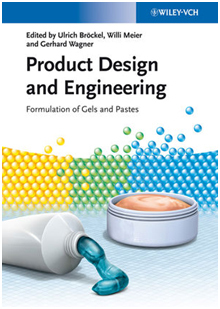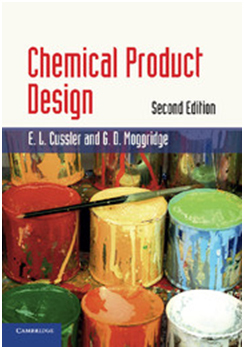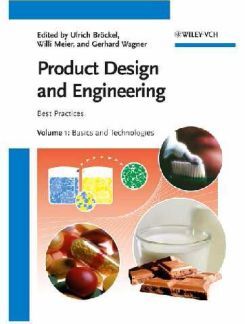EFCE Journals and Books
EFCE Journals
In 2003 the EFCE adopted the title Chemical Engineering Research and Design (ChERD - Part A) as its official journal.
From 2004 its sister titles, Process Safety and Environmental Protection (Part B), and Food and Bioproduct Processing (Part C) have also been adopted.
A fourth journal, which is available purely online, has been launched in May 2006: Part D: Education for Chemical Engineers.
In 2015, a new journal on Sustainability Production and Consumption (SPC) has been launched at the tenth European Congress of Chemical Engineering (ECCE 10) in Nice, France: Part E: Sustainability Production and Consumption (SPC). Press release
Two open access journals complete the set of seven journals: Digital Chemical Engineering and Carbon Capture, Science and Technology.
The journals are produced by the Institution of Chemical Engineers (IChemE) in partnership with the publisher Elsevier.
From August 2010 to May 2016, EFCE published its up-to-date EFCE News in the form of an attractive A5 insert in ChERD.
Journal news are regularly published in the EFCE e-newsletter.
As a member of an EFCE Member Society you can subscribe at preferential rates. Please click here for details.
Modern Drying Technology
Tsotsas, E. / Mujumdar, A. (eds.)
Wiley VCH
Print ISBN: 9783527315543
Online ISBN: 9783527631728
These five-volume series provide a comprehensive overview of all important aspects of drying technology like computational tools at different scales (Volume 1), modern experimental and analytical techniques (Volume 2), product quality and formulation (Volume 3), energy savings (Volume 4) and process intensification (Volume 5)
Based on high-level cutting-edge results contributed by internationally recognized experts in the various treated fields, this book series will help engineers achieve greater efficiency for an unavoidable, yet vital process
Located at the intersection of the two main approaches in modern chemical engineering, product engineering and process systems engineering, the series brings theory into practice in order to improve the quality of high-value dried products, save energy, and cut the costs of drying processes
Publication in Mechanics of Particulate Solids
Standard smykové zkousky partikulárních hmot pomocí Jenikeho smykového stroje
Zegzulka, J. [Übs.]:
VSB-TU Ostrava, Ostrava (2006)
ISBN 80-248-1051-4
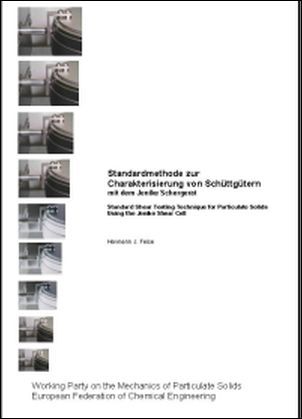
Since 1969 the characterization of bulk solids has been the focus of the work of the "Working Party on the Mechanics of Particulate Solids" of the European Federation of Chemical Engineers. Led by John Williams and Jan Novosad the WPMPS developed the first international standard on the measurement of the flow properties of bulk solids during the 1970's and 80's. After its publication in 1989 this "Standard Shear Testing Technique for Particulate Solids Using the Jenike Shear Cell" or SSTT became the common worldwide basis for silo design.
Later work on shear testing, like the BCR 215 or the ASTM Standard D6128 "Standard Test Method for Shear Testing of Bulk Solids Using the Jenike Shear Cell", although making small modifications to the method, made the SSTT an internationally acknowledged officially standardized method.
Globalization has made us feel that anything documented in internationally accessible standards must be usable for everybody. However, the knowledge about proper shear testing spreads only slowly through the educated world. It is my believe that one reason for this unsatisfactory state remains the language barrier. Therefore, I am very glad that after the German translation published in 2005, now an Czech edition of the SSTT becomes available. I would specifically like to thank Dr. Jiri Zegzulka of the University of Ostrava who provided the translation, for his great efforts. I hope that this translation will help to spread the knowledge of shear testing and flow properties especially in the new member countries of the European Union.
Ludwigshafen, 21. September 2005
Hermann Feise
(Chairman Working Party on the Mechanics of Particulate Solids)
Standardmethode zur Charakterisierung von Schüttgütern mit dem Jenike Schergerät
DECHEMA, Frankfurt/Main, D (2005)
ISBN 3-89746-058-0

Seit 1969 befasst sich die "Working Party on the Mechanics of Particulate Solids" der European Federation of Chemical Engineers, EFCE, mit der Charakterisierung von Schüttgütern. Unter der Führung von John Williams und Jan Novosad entstand in den siebziger und achtziger Jahren ein gemeinsamer Standard, in dem erstmals die Methodik des Scherversuchs in einer Jenike-Scherzelle zur Bestimmung des Fließverhaltens von Schüttgütern umfassend beschrieben wurde. Seit der ersten Fassung der SSTT (Standard Shear Testing Technique for Particulate Solids Using the Jenike Shear Cell) im Jahr 1989 ist dieser Standard die Grundlage für die Auslegung von Silos für nahezu alle Schüttgüter der Welt.
Nach Abschluß der Arbeiten zur SSTT sind im Rahmen des Forschungsvorhabens BCR 215 Scherversuche von einigen Instituten in Europa durchgeführt worden, wofür wiederum ein feines Kalksteinpulver verwendet wurde. Aufgrund der immer noch vorhandenen Streuungen der Messwerte wurde die SSTT in einigen Punkten modifiziert bzw. ergänzt. Im folgenden werden Hinweise auf diese Version der SSTT mit dem Hinweis SSTT-BCR6 gekennzeichnet. Ein Teil dieser Modifikationen hat auch Eingang in die im folgenden beschriebenen Arbeiten der ASTM gefunden.
Im Jahr 1998 veröffentlichte die ASTM den Standard D6128 "Standard Test Method for Shear Testing of Bulk Solids Using the Jenike Shear Cell", in dem die Methodik des Jenike Scherversuches festgeschrieben wurde. Basierend auf dem schon in der SSTT beschriebenen Vorgehen steht mit ASTM D6773 auch eine Norm für Scherversuche mit dem Ringschergerät zur Verfügung.
Trotz aller Globalisierung musste ich bei vielen Anlässen feststellen, dass das Wissen über die SSTT und das richtige Vorgehen bei Scherversuchen nur langsam allgemein bekannt wird. Ein Hinderungsgrund ist auch heute noch die Sprachbarriere. Aus diesem Grund hat mich seit 1998 die SSTT auf vielen Flügen begleitet. Nirgends hat der geneigte Ingenieur schließlich mehr Ruhe, um sich in ein Buch zu vertiefen. Aus meinen zunächst sehr bruchstückhaften Notizen entstand dann im Laufe von vier Jahren diese erste Übersetzung der SSTT ins Deutsche. Ich hoffe, dass sie zu einer weiteren und schnelleren Verbreitung des Wissens über Scherversuche und Fließeigenschaften, nicht nur in Deutschland, sondern auch und gerade in den neuen Mitgliedsländern der Europäischen Union, beitragen kann. Es freut mich daher besonders, dass die Dechema sich bereit erklärt hat, diese Übersetzung zu vertreiben.
Mein besonderer Dank gilt Birgit Dullinger, die in den vier Jahren immer an dieser Übersetzung mitgeschrieben und geduldig meine wenig leserlichen Notizen in eine veröffentlichbare Form gebracht hat. Mein Dank gilt auch Detlef Höhne und Harald Wilms, die mit mir als deutsche Delegierte in der Working Party on the Mechanics of Particulate Solids arbeiten und die Aufgabe des Korrekturlesens übernommen und viele Hinweise auf neuere Erkenntnisse beigetragen haben.
Ludwigshafen, den 15. Mai 2004
Hermann Feise
(Chairman Working Party on the Mechanics of Particulate Solids)
IChemE, EFCE:
Standard Shear Testing Technique for particulate solids using the Jenike shear cell (SSTT)
Rugby, Warwickshire, UK (1989)
ISBN 0-85295-232-5
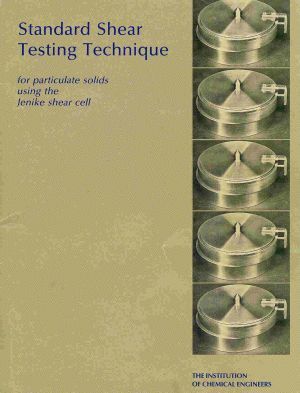
One of the tasks of the Working Party on the Mechanics of Particulate Solids (WPMPS) of the European Federation of Chemical Engineering has been to assess the reliability and reproducibility of measurements of the flow properties of particulate solids.
In 1979, J. Schwedes presented a survey of the various types of equipment used for measuring the flow properties of particulate solids and pointed out that the most widely used and versatile instrument for this purpose was the Jenike Shear Cell . The WPMPS therefore decided to investigate this measuring technique in more detail.
As a first step samples of a fine calcite powder were distributed to over 20 laboratories all over the world and in each laboratory the flow properties were measured using the Jenike Shear Cell available using the technique customary in that laboratory. A comparison of the measurements showed that there was some scatter in the results obtained.
After detailed analysis of all the experimental results it was concluded that for reliable measurements of the flow properties of particulate solids using the Jenike Shear Cell a standardised testing technique should be specified in sufficient detail to eliminate operator and equipment variation.
The only detailed description of the Jenike Shear Cell and its use is the manual prepared by Jenike & Johanson Inc., 'Flow Factor Tester and Consolidating Bench Operating Instructions (1979 version) . These operating instructions are only available on the purchase of a shear tester.
The WPMPS therefore set up a task group to draw up a Standard Shear Testing Technique (SSTT). Dr. A. W. Jenike provided further detailed instructions for operating the Jenike Shear Cell to aid the task group in its work. From these detailed instructions and the experience of members of WPMPS a new Standard Testing Procedure has been drawn up which in some details differs from that described in the Jenike and Johanson manual cited above.
Since a basic understanding of the principles of shear testing is needed for the reliable measurement of particulate solids flow, an introductory chapter 'Principles of Shear Testing' has been included as Chapter 2.
The present technique is based on the current state of the art but it is expected that the SSTT may need to be revised after further research. The SSTT is intended to help all those engaged in shear testing or who need to be acquainted with the technique. It is recommended that those who do not have practical experience should first attend a course on shear testing. Such courses are presented by several institutions and consulting companies.
Since the terminology used in discussing the mechanics of particulate solids is not completely standardised, the WPMPS drew up a Glossary of Terms on Storage and Flow of Particulate Solids which is included as an Appendix.
Product Design and Engineering: Formulation of Gels and Pastes
Edited by Ulrich Bröckel, Willi Meier and Gerhard Wagner
Wiley VCH, 372 pages, September 2013
ISBN: 978-3-527-33220-5
Covering the whole value chain - from product requirements and properties via process technologies and equipment to real-world applications - this reference represents a comprehensive overview of the topic. The editors and majority of the authors are members of the European Federation of Chemical Engineering, with backgrounds from academia as well as industry. Therefore, this multifaceted area is highlighted from different angles: essential physico-chemical background, latest measurement and prediction techniques, and numerous applications from cosmetic up to food industry.
Recommended reading for process, pharma and chemical engineers, chemists in industry, and those working in the pharmaceutical, food, cosmetics, dyes and pigments industries.
Chemical Product Design
2nd edition, Part of Cambridge Series in Chemical Engineering
G.D. Moggridge and E.L. Cussler
Cambridge University Press 2011
ISBN: 9780521168229
The chemical industry is changing, going beyond commodity chemicals to a palette of higher value added products. This groundbreaking book, now revised and expanded, documents this change and shows how to meet the challenges implied. Presenting a four-step design process - needs, ideas, selection, manufacture - the authors supply readers with a simple design template that can be applied to a wide variety of products. Four new chapters on commodities, devices, molecules/drugs and microstructures show how this template can be applied to products including oxygen for emphysema patients, pharmaceuticals like taxol, dietary supplements like lutein, and beverages which are more satisfying. For different groups of products the authors supply both strategies for design and summaries of relevant science. Economic analysis is expanded, emphasizing the importance of speed-to-market, selling ideas to investors and an expectation of limited time in the market. Extra examples, homework problems and a solutions manual are available.
Product Design and Engineering (2 Volumes)
Best Practice
Wiley VCH 2007. 760 pages with 355 figures and 60 tables. 2 Volumes, Hardcover.
ISBN: 978-3-527-31529-1
(out of stock)
Covering the whole value chaine - from product requirements and properties via process technologies and equipment to real-world applications - the two-volime work represents a comprehensive overview of the topic.
The editors and majority of the authors are members of the European Federation of Chemical Engineering, and they describe here best practice in product design and production, taking in fundamentals, technologies and applications.
Volume 1 is devoted to basics and technologies, while Volume 2 looks at raw materials, additives and applications. Various industrial examples illustrate the different cases treated.
Publications in Fluid Separations
'Recommended test mixtures for distillation columns'
U. Onken and W. Arlt, 2nd Edition, 1990

